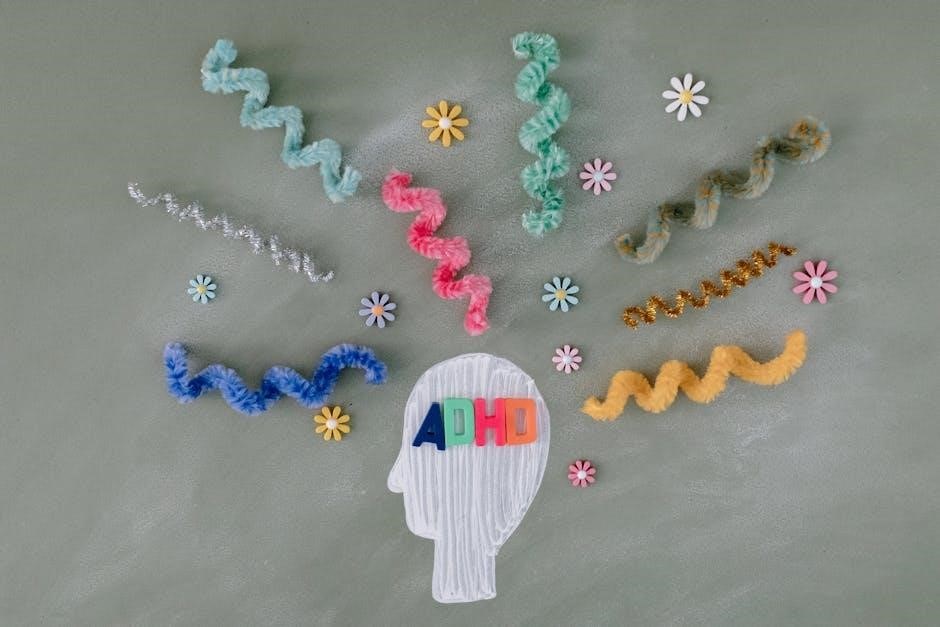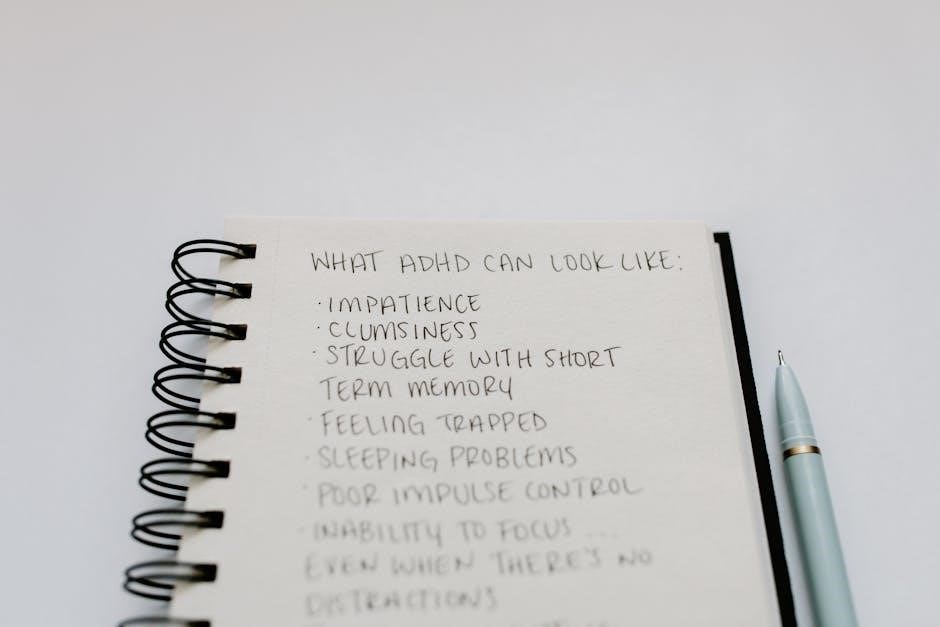
Attention Deficit Hyperactivity Disorder (ADHD): A Comprehensive Overview
Attention Deficit Hyperactivity Disorder (ADHD) is a neurodevelopmental condition impacting children and adults. It’s characterized by patterns of inattention, hyperactivity, and impulsivity. Understanding ADHD requires examining diagnostic criteria, treatment options, and resources. This overview will explore the key aspects of ADHD, supporting informed awareness and effective strategies for individuals and families affected.
What is ADHD? Definition and Core Symptoms
Attention Deficit Hyperactivity Disorder (ADHD) is a neurodevelopmental disorder primarily characterized by persistent patterns of inattention, hyperactivity, and impulsivity that are pervasive and inappropriate for a person’s developmental stage. These symptoms typically manifest before the age of 12 and significantly impair functioning in various settings, including school, work, and social situations. It is essential to remember that occasional instances of inattentiveness, hyperactivity, or impulsivity do not automatically indicate ADHD. The disorder is diagnosed when these behaviors are chronic, severe, and demonstrably disrupt daily life.

Inattentive symptoms include difficulty sustaining attention, being easily distracted, forgetfulness, and struggling to follow instructions. Hyperactive symptoms involve excessive fidgeting, restlessness, difficulty staying seated, and talking excessively. Impulsive symptoms manifest as difficulty waiting their turn, interrupting others, and acting without thinking. The manifestation and severity of these symptoms can vary considerably among individuals with ADHD. Some individuals may predominantly exhibit inattentive symptoms, while others may primarily display hyperactive-impulsive symptoms. Many individuals experience a combination of both, leading to challenges in various aspects of life. Early identification and appropriate intervention are crucial in managing ADHD effectively.
ADHD Prevalence and Statistics
Attention Deficit Hyperactivity Disorder (ADHD) affects a significant portion of the population, making it a prominent neurodevelopmental disorder worldwide. Prevalence rates vary across studies due to differing diagnostic criteria and methodologies. However, estimates suggest that approximately 5% to 8% of children globally are diagnosed with ADHD. In the United States, the Centers for Disease Control and Prevention (CDC) estimates that around 6.1 million children aged 2-17 years have been diagnosed with ADHD as of 2016.

While ADHD is often associated with childhood, it persists into adulthood for many individuals. Studies indicate that approximately 2.5% to 5% of adults experience ADHD symptoms that significantly impair their daily functioning. This means that millions of adults worldwide continue to grapple with the challenges associated with ADHD. Furthermore, males are more frequently diagnosed with ADHD in childhood than females. However, this gender disparity tends to narrow in adulthood, as ADHD may be underdiagnosed in females due to differences in symptom presentation. Understanding the prevalence and statistical trends of ADHD is crucial for healthcare professionals, educators, and policymakers.
ADHD Diagnosis in Children
Attention Deficit Hyperactivity Disorder (ADHD) diagnosis in children requires a comprehensive evaluation that considers multiple sources of information. This process typically involves parents, teachers, and healthcare professionals collaborating to assess a child’s behavior and functioning. The diagnosis adheres to standardized criteria outlined in the Diagnostic and Statistical Manual of Mental Disorders (DSM). These criteria include symptoms of inattention, hyperactivity, and impulsivity that must be present before age 12 and persist for at least six months.
The diagnostic process involves a clinical interview, where the healthcare provider gathers information about the child’s developmental history, medical background, and current symptoms. Parents and teachers are often asked to complete questionnaires or rating scales that provide insights into the child’s behavior across different settings. Standardized behavioral assessments may also be used to evaluate the child’s attention, impulsivity, and activity levels. It is crucial to rule out other potential causes of the child’s symptoms, such as learning disabilities, anxiety disorders, or mood disorders. A thorough medical examination may be necessary to identify any underlying medical conditions contributing to the child’s difficulties.
ADHD Diagnosis in Adults
Attention Deficit Hyperactivity Disorder (ADHD) diagnosis in adults presents unique challenges compared to diagnosing children, as symptoms can manifest differently over time. The diagnostic process begins with a comprehensive clinical interview to gather information about the individual’s developmental history, current symptoms, and functional impairments. Since ADHD is considered a neurodevelopmental disorder, evidence of symptoms during childhood is essential for diagnosis. However, adults may not always have clear memories or documentation of their childhood behaviors, requiring reliance on collateral information from family members or historical records.
The assessment includes evaluating symptoms of inattention, hyperactivity, and impulsivity, as defined by the Diagnostic and Statistical Manual of Mental Disorders (DSM). However, the presentation of these symptoms can vary in adults. Inattention may manifest as difficulty organizing tasks, prioritizing responsibilities, or sustaining focus on work or hobbies. Hyperactivity may present as restlessness, fidgeting, or excessive talking, while impulsivity can lead to rash decision-making, difficulty waiting in line, or interrupting others. Standardized questionnaires and rating scales designed for adults can help quantify these symptoms.
ADHD Subtypes: Inattentive, Hyperactive-Impulsive, and Combined
Attention Deficit Hyperactivity Disorder (ADHD) is not a monolithic condition; it encompasses distinct subtypes, each characterized by a predominant set of symptoms. The Diagnostic and Statistical Manual of Mental Disorders (DSM) recognizes three primary subtypes: Inattentive, Hyperactive-Impulsive, and Combined.

The Inattentive subtype, previously known as Attention Deficit Disorder (ADD), is marked by significant difficulties in focusing, sustaining attention, and following through with tasks. Individuals with this subtype may struggle with organization, be easily distracted, and often appear forgetful. They may have trouble listening attentively, making careless mistakes, and avoiding activities that require sustained mental effort.
The Hyperactive-Impulsive subtype is characterized by excessive fidgeting, restlessness, and difficulty staying seated. Individuals may talk excessively, interrupt conversations, and struggle to wait their turn. Impulsivity can manifest as making hasty decisions without considering the consequences and engaging in risky behaviors.
The Combined subtype encompasses individuals who exhibit significant symptoms of both inattention and hyperactivity-impulsivity.
The Role of DSM Criteria in ADHD Diagnosis
The Diagnostic and Statistical Manual of Mental Disorders (DSM) serves as the cornerstone for diagnosing Attention Deficit Hyperactivity Disorder (ADHD). The DSM provides standardized criteria that clinicians use to assess and identify ADHD in individuals across different age groups. These criteria are essential for ensuring accurate and consistent diagnoses, guiding treatment decisions, and facilitating research efforts.
The DSM outlines specific symptoms and criteria for each of the ADHD subtypes: Inattentive, Hyperactive-Impulsive, and Combined. To meet the diagnostic threshold, individuals must exhibit a certain number of symptoms from either the inattentive or hyperactive-impulsive categories, or both.
For children, at least six symptoms must be present in either category. For adults, at least five symptoms are required. These symptoms must have persisted for at least six months and must be present in multiple settings, such as home, school, or work. Furthermore, the symptoms must cause significant impairment in social, academic, or occupational functioning.
Common ADHD Co-morbidities
Attention Deficit Hyperactivity Disorder (ADHD) frequently co-occurs with other mental health conditions, known as co-morbidities. Understanding these co-existing conditions is crucial for comprehensive diagnosis and treatment planning. Common co-morbidities include anxiety disorders, mood disorders such as depression and bipolar disorder, learning disabilities, oppositional defiant disorder (ODD), and conduct disorder (CD).
Anxiety disorders, such as generalized anxiety disorder and social anxiety disorder, are often seen alongside ADHD. The constant struggle with inattention and impulsivity can lead to increased stress and worry, contributing to anxiety symptoms. Mood disorders, including depression, can also occur as individuals with ADHD experience difficulties in managing their symptoms and achieving their goals.
Learning disabilities, such as dyslexia and dysgraphia, are frequently found in individuals with ADHD, impacting academic performance and self-esteem. Oppositional defiant disorder (ODD) and conduct disorder (CD) are behavioral disorders characterized by defiance, aggression, and rule-breaking behavior, which can further complicate the challenges faced by individuals with ADHD.
Recognizing and addressing these co-morbidities is essential for improving the overall well-being and outcomes for individuals with ADHD.

ADHD Treatment Options: Medication
Medication is a common and effective treatment option for managing the symptoms of Attention Deficit Hyperactivity Disorder (ADHD). Stimulant medications are often the first-line treatment, as they can help improve focus, attention span, and reduce impulsivity and hyperactivity. These medications work by increasing the levels of certain neurotransmitters in the brain, such as dopamine and norepinephrine, which play a crucial role in attention and behavior regulation.
Common stimulant medications include methylphenidate (e.g., Ritalin, Concerta) and amphetamine (e.g., Adderall, Vyvanse). Non-stimulant medications, such as atomoxetine (Strattera) and guanfacine (Intuniv), are also available and can be used as an alternative or in combination with stimulants.
It is important to work closely with a healthcare professional to determine the most appropriate medication and dosage for each individual, as medication responses can vary. Regular monitoring and adjustments may be necessary to optimize the effectiveness of the medication and minimize potential side effects. Side effects may include decreased appetite, sleep disturbances, and increased heart rate.
Medication can be a valuable tool in managing ADHD symptoms, but it is often most effective when combined with other treatment approaches, such as therapy and behavioral interventions.
ADHD Treatment Options: Therapy and Behavioral Interventions
Therapy and behavioral interventions are vital components of a comprehensive ADHD treatment plan, offering strategies to manage symptoms and improve daily functioning. These approaches focus on teaching practical skills and coping mechanisms to individuals with ADHD and their families. Cognitive Behavioral Therapy (CBT) helps individuals identify and modify negative thought patterns and behaviors that contribute to ADHD symptoms. CBT can improve time management, organization, and problem-solving skills.
Behavioral therapy, often used with children, involves setting clear expectations, providing positive reinforcement for desired behaviors, and using consistent consequences for undesired behaviors. Parent training programs teach parents effective strategies for managing their child’s behavior, such as creating structured routines, using reward systems, and implementing consistent discipline.
Social skills training helps individuals with ADHD improve their social interactions and communication skills. This can involve learning how to initiate and maintain conversations, understand social cues, and resolve conflicts effectively.
Therapy and behavioral interventions are often used in conjunction with medication to provide a well-rounded treatment approach. These strategies empower individuals with ADHD to develop self-management skills, improve relationships, and achieve their goals. Consistent implementation and ongoing support are essential for maximizing the benefits of therapy and behavioral interventions in managing ADHD symptoms.
ADHD and Life Expectancy
Recent research has sparked concern regarding the potential impact of ADHD on life expectancy. Studies suggest that individuals with ADHD may face a statistically shorter lifespan compared to those without the condition; This difference is not directly caused by ADHD itself, but rather by the increased risks associated with certain behaviors and co-occurring conditions.
Individuals with ADHD are more prone to accidents, injuries, and impulsive decision-making, which can lead to risky behaviors. These behaviors can increase the likelihood of accidental deaths or injuries. Additionally, ADHD often co-occurs with other mental health conditions such as anxiety, depression, and substance use disorders, all of which can negatively impact overall health and longevity.
However, it’s crucial to emphasize that this is not a deterministic outcome. With proper diagnosis, treatment, and management, individuals with ADHD can mitigate these risks and lead fulfilling, healthy lives. Early intervention, comprehensive treatment plans, and ongoing support are essential in promoting positive health outcomes and reducing potential risks.
Lifestyle factors also play a significant role. Maintaining a healthy diet, engaging in regular physical activity, avoiding substance abuse, and practicing mindfulness can all contribute to improved health and well-being. By addressing co-occurring conditions and adopting healthy lifestyle choices, individuals with ADHD can significantly improve their overall health and life expectancy.
Resources for Families and Adults with ADHD
Navigating life with ADHD can be challenging, but numerous resources are available to provide support and guidance for both families and adults. These resources offer valuable information, practical strategies, and a sense of community, empowering individuals to manage their ADHD effectively.
For families, organizations like CHADD (Children and Adults with Attention-Deficit/Hyperactivity Disorder) offer educational materials, support groups, and advocacy services. These resources help parents understand ADHD, learn effective parenting techniques, and connect with other families facing similar challenges. Educational resources often include webinars, workshops, and online articles covering topics such as behavioral management, academic accommodations, and medication options.
Adults with ADHD can benefit from organizations like ADDA (Attention Deficit Disorder Association), which provides resources tailored to their specific needs. These include support groups, coaching services, and online forums where individuals can share experiences, exchange tips, and build connections. Furthermore, professional organizations like the American Psychological Association (APA) offer directories of qualified therapists and psychologists specializing in ADHD treatment.
Online resources, such as websites and podcasts, offer a wealth of information on various aspects of ADHD, including diagnosis, treatment, and coping strategies. These platforms often feature expert interviews, personal stories, and practical advice. Additionally, local community centers and mental health clinics may offer ADHD-specific programs and services, providing accessible support within your area.
Current Research and Emerging Trends in ADHD
The field of ADHD research is continuously evolving, leading to new insights into the disorder’s causes, diagnosis, and treatment. Current research explores various aspects of ADHD, from genetic and neurological factors to innovative therapeutic approaches. These advancements aim to improve the lives of individuals with ADHD and enhance our understanding of this complex condition.
One prominent area of research focuses on the genetic basis of ADHD. Studies have identified several genes that may contribute to the disorder, providing potential targets for future interventions. Neuroimaging studies are also shedding light on the brain structures and functions associated with ADHD, helping to refine diagnostic methods and personalize treatment strategies.
Emerging trends in ADHD treatment include non-pharmacological interventions, such as neurofeedback and cognitive training. These approaches aim to improve attention, executive function, and self-regulation skills through targeted exercises and feedback mechanisms. Additionally, researchers are exploring the potential of digital health technologies, such as mobile apps and wearable devices, to monitor symptoms, deliver interventions, and promote self-management.
Another area of interest is the study of ADHD in adults, as the disorder often persists beyond childhood. Research is investigating the long-term outcomes of ADHD, as well as the unique challenges faced by adults with the condition. This includes examining the impact of ADHD on career, relationships, and overall well-being, leading to the development of tailored interventions to support adult populations.





